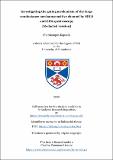Files in this item
Investigating the gating mechanism of the large conductance mechanosensitive channel by SDSL and EPR spectroscopy
Item metadata
| dc.contributor.advisor | Pliotas, Christos | |
| dc.contributor.advisor | Penedo, Carlos | |
| dc.contributor.author | Kapsalis, Charalampos | |
| dc.coverage.spatial | 201 | en_US |
| dc.date.accessioned | 2024-03-05T10:21:36Z | |
| dc.date.available | 2024-03-05T10:21:36Z | |
| dc.date.issued | 2020-12-01 | |
| dc.identifier.uri | https://hdl.handle.net/10023/29423 | |
| dc.description.abstract | Mechanosensation is the ability of cells to sense and respond to mechanical stimuli deriving from their environment. Despite being a fundamental cellular response though, the molecular basis of mechanotransduction is still largely unknown. The mechanosensitive (MS) channel of large conductance, MscL, is expressed by all prokaryotes, it is the MS channel with the highest pressure activation threshold and acts as a last resort safety valve. It responds to the lateral tension of the membrane and, by opening its pore of ≈35Å, it rapidly allows solutes to exit the cell in order to rescue it from lysis during severe hypoosmotic shock. Despite its importance and abundance, the gating and activation mechanism of MscL has not been elucidated. Thus, in the main project presented, MscL’s gating mechanism is investigated as a means to gain insight on the mode of mechanosensation itself. Activation of the channel through site-directed spin labelling (SDSL) reveals that the nano-pockets, transmembrane hydrophobic crevices of the protein, are crucial for the activation of MscL. SDSL at the nano-pockets’ entrance hinders lipid acyl chains from penetrating them and this causes the channel to adopt a more expanded state, as demonstrated by EPR spectroscopy, which is more prone to opening, as revealed by single-molecule electrophysiology. Since MscL is only found in prokaryotes, manipulation of its gating mechanism could lead to the channel being used as a novel form of antibiotic target. Moreover, due to its large pore, it could also be utilized in nanotechnological applications for targeted drug delivery. | en_US |
| dc.language.iso | en | en_US |
| dc.publisher | University of St Andrews | |
| dc.rights | Creative Commons Attribution-NonCommercial-NoDerivatives 4.0 International | * |
| dc.rights.uri | http://creativecommons.org/licenses/by-nc-nd/4.0/ | * |
| dc.subject | Mechanosensitive channels | en_US |
| dc.subject | Large conductance | en_US |
| dc.subject | MscL | en_US |
| dc.subject | Electron paramagnetic resonance | en_US |
| dc.subject | EPR | en_US |
| dc.subject | Site-directed spin labelling | en_US |
| dc.subject | Electrophysiology | en_US |
| dc.title | Investigating the gating mechanism of the large conductance mechanosensitive channel by SDSL and EPR spectroscopy | en_US |
| dc.type | Thesis | en_US |
| dc.contributor.sponsor | University of St Andrews. School of Biology | en_US |
| dc.contributor.sponsor | Royal Society of Edinburgh (RSE) | en_US |
| dc.contributor.sponsor | Tenovus Scotland | en_US |
| dc.contributor.sponsor | Carnegie Trust for the Universities of Scotland | en_US |
| dc.type.qualificationlevel | Doctoral | en_US |
| dc.type.qualificationname | PhD Doctor of Philosophy | en_US |
| dc.publisher.institution | The University of St Andrews | en_US |
| dc.publisher.department | Biomedical Sciences Research Complex, St Andrews | en_US |
| dc.rights.embargodate | 2022-10-29 | en |
| dc.rights.embargoreason | Thesis restricted in accordance with University regulations. Part (Chapter 4 (all), Chapter 6 (all), Chapter 3 (Section 3.2.7) and Chapter 7(Sections 7.2.2 and 7.2.4)) restricted until 29 October 2022 | en |
| dc.identifier.doi | https://doi.org/10.17630/sta/803 | |
| dc.identifier.grantnumber | T15/41 | en_US |
The following licence files are associated with this item:
This item appears in the following Collection(s)
Except where otherwise noted within the work, this item's licence for re-use is described as Creative Commons Attribution-NonCommercial-NoDerivatives 4.0 International
Items in the St Andrews Research Repository are protected by copyright, with all rights reserved, unless otherwise indicated.



